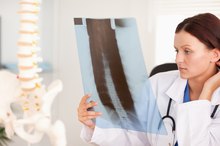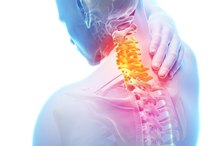What does fact checked mean?
At Healthfully, we strive to deliver objective content that is accurate and up-to-date. Our team periodically reviews articles in order to ensure content quality. The sources cited below consist of evidence from peer-reviewed journals, prominent medical organizations, academic associations, and government data.
The information contained on this site is for informational purposes only, and should not be used as a substitute for the advice of a professional health care provider. Please check with the appropriate physician regarding health questions and concerns. Although we strive to deliver accurate and up-to-date information, no guarantee to that effect is made.
Complications of Lumbar Fusion Surgery
The incidence of spinal fusion surgery increased 220 percent from 1999 to 2001, according to research done by the University of Washington 1. More than 122,000 spinal fusion procedures were done in 2001. The most common reason for fusion was degenerative disease, commonly known as arthritis of the spine. Patients who fail a trial of conservative therapy for low back pain secondary to degenerative disease may be candidates for lumbar spinal fusion surgery. Complications after lumbar fusion are higher in people who smoke, diabetics, the elderly and the obese according to the American Academy of Orthopedic Surgeons 2. Potential complications can be life altering.
If you are experiencing serious medical symptoms, seek emergency treatment immediately.
Hardware Fracture
Lumbar spinal fusion requires “hardware”, or metal rods and screws in order to stabilize the spine. During surgery, the vertebrae that are impinging on nerves are removed in order to provide space for the spinal cord and spinal nerves. This is called decompression of the nerves. By removing the vertebrae and the pressure on the nerves, relief from pain can be achieved. But without the bone of the vertebrae to support the spinal column, the spine would collapse. Placing rods and screws along either side of the spinal column provides the necessary support while the fusion heals. Once the fusion heals, the hardware is not necessary, although it is not usually removed. While the fusion is healing, the hardware can occasionally break or move out of place. This is called hardware fracture and requires another operation.
- Lumbar spinal fusion requires “hardware”, or metal rods and screws in order to stabilize the spine.
- During surgery, the vertebrae that are impinging on nerves are removed in order to provide space for the spinal cord and spinal nerves.
Spinal Cord Injury
What Are the Causes of Damage to the Greater Auricular Nerve & Numbness?
Learn More
Paralysis is the most serious of complications resulting from lumbar fusion surgery. Although a rare complication, paralysis is a devastating, life-altering complication. Other complications resulting from injury to the cord include injury of the bowel and bladder. The bladder and bowel are controlled by spinal nerves in the lower lumbar area. Incontinence, bladder spasms and chronic constipation or stool leakage can be the result of lumbar fusion surgery, according to the National Institutes of Health 4. The amount of damage is dependent on the area of injury. If the spinal cord is injured, complete loss of bowel and bladder function could occur. Spinal nerve injuries in the lumbar spine can cause sexual impairment such as erectile dysfunction.
- Paralysis is the most serious of complications.
- If the spinal cord is injured, complete loss of bowel and bladder function could occur.
Persistent Pain
The University of Maryland Spine Center states that the most common complication of lumbar fusion surgery is persistent pain 3. Low back pain may persist even though patients experience significant relief from the radiating pain in their legs. Normal sensory perception in spinal nerves may not return if there has been long-term compression from a herniated disc or vertebral fracture. The nerves continue to send pain signals even if the cause of the pain has been removed. This creates chronic pain syndrome. Rarely does the hardware cause persistent pain.
- The University of Maryland Spine Center states that the most common complication of lumbar fusion surgery is persistent pain 3.
- Low back pain may persist even though patients experience significant relief from the radiating pain in their legs.
Related Articles
References
- University of Washington.edu: Epidemiology of Spinal Surgery: Rates and Trends
- American Academy of Orthopedic Surgeons: Lumbar Spinal Stenosis
- University of Maryland Spine Center.edu: Complications of Spine Surgery
- National Institutes of Health: Spinal Cord Trauma
- Castillo, H., et. al., Lumbar discectomy is associated with higher rates of lumbar fusion. Spine. May 2018. doi: 10.1016/j.spinee.2018.05.016
- Deyo, R., et. al., Overtreating chronic back pain: time to back off? J Am Board Fam Med. Jan - Feb 2009. doi:10.3122/jabfm.2009.01.080102
Writer Bio
Catherine Schaffer has been writing since 1990. Her articles have appeared in many medical journals and textbooks. Schaffer holds a Bachelor of Science from Baylor College of Medicine and a physician assistant certificate. She has written health and nutrition articles for various websites and teaches movement and nutrition to help women overcome chronic diseases and obesity.









